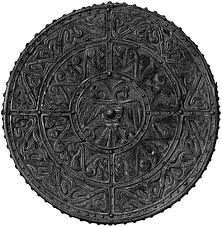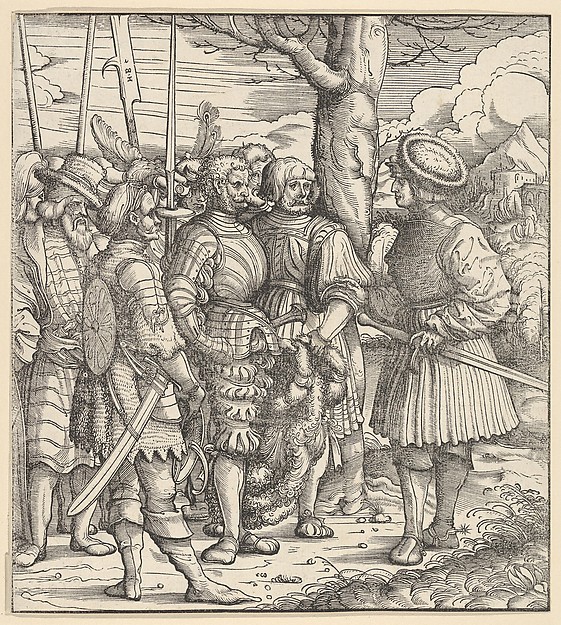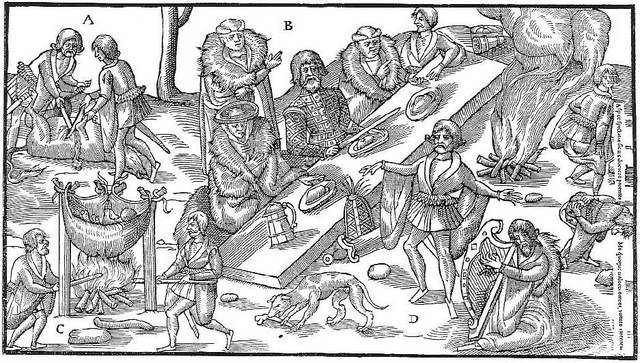| Author |
Message |
|
Stephen Curtin
|
 Posted: Fri 07 Jul, 2017 5:52 pm Post subject: Posted: Fri 07 Jul, 2017 5:52 pm Post subject: |
 |
|
| Richard Worthington wrote: | | The shield descended in the Hamilton Rowan family, but there's nothing to indicate that it was made for the family. So there's no reason it couldn't be Irish, and no reason it couldn't be 16th c. |
Yes the Hamilton's are a Lowland family, so this targe is unlikely to have been originally made for a one of them. There isn't a reason that this couldn't be a 16th century Irish targe, but neither is there evidence that it is. It could just have likely been 17th or 18th century Scottish.
| Quote: | | Stylistically, it has a lot in common with a number of Highland targes. There are two differences, though: no boss, and many fewer brass nails than is typical in the Scottish. |
The lack of a boss is not unknown on Scottish targes, and to me the number and pattern of nails is reminiscent of the targe associated with the McDonald's of the Isles.
 Attachment: 12.19 KB Attachment: 12.19 KB

Éirinn go Brách
|
|
   |
 |
Richard Worthington

|
 Posted: Fri 07 Jul, 2017 8:05 pm Post subject: Posted: Fri 07 Jul, 2017 8:05 pm Post subject: |
 |
|
Since the population size of Irish targes = 2, it's hard to draw any conclusions. The Bell/Hamilton Rowan shield could be Scottish, or not. Personally, I wonder if there's a Montrose-"Wild Irish" connection. But there's no way to prove daydreams. 
Were targes obsolete in Ireland after the 16th c.? Could that be the reason for the dates given?
Only the leather on the double-headed eagle targe is original. It was found rolled up, and later restored. There is a near identical targe, with a galley in place of the eagle at Inverary. I don't have any other information on that one, but I still wonder if fully tooled with sparse nails could indicate early.
Several of the targes illustrated by Drummond are now at Inverary--a nice collection.
|
|
  |
 |
Richard Worthington

|
 Posted: Fri 07 Jul, 2017 8:15 pm Post subject: Posted: Fri 07 Jul, 2017 8:15 pm Post subject: |
 |
|
|
P.S The Bell and the double headed eagle targes are of the same class, i.e. segmented (in this case quartered) concentric circles of brass nails, with tooled leather and no boss. The Scottish targes with no central boss almost always have a large nail marking the centre.
|
|
  |
 |
|
Neal Matheson
|
 Posted: Sat 08 Jul, 2017 4:05 am Post subject: Posted: Sat 08 Jul, 2017 4:05 am Post subject: |
 |
|
I'm going through some of my old research to see if I have anything that can help. I dug this out
"At the siege of Haddington in 1548 Jean de Beaugue describes Scots Highlanders using shields similar to the lowlanders".
There is a great depiction of a shield from a grave slab that looks very similar to a later targe. Maybe the highlanders were using the more improvised sounding shield described in legal documents of the time "no cost but a hide" or lowlanders were using shields that we would think looked like later targes.
Neal
http://www.seeknottheancestors.com/
|
|
   |
 |
|
Stephen Curtin
|
 Posted: Sat 08 Jul, 2017 4:38 am Post subject: Posted: Sat 08 Jul, 2017 4:38 am Post subject: |
 |
|
Hi Neal.
| Neal Matheson wrote: | I'm going through some of my old research to see if I have anything that can help. I dug this out
"At the siege of Haddington in 1548 Jean de Beaugue describes Scots Highlanders using shields similar to the lowlanders".
There is a great depiction of a shield from a grave slab that looks very similar to a later targe. Maybe the highlanders were using the more improvised sounding shield described in legal documents of the time "no cost but a hide" or lowlanders were using shields that we would think looked like later targes. |
Well the Lowlanders that de Beaugue was referring to were archers, so I think it most likely that both they and the Highlanders were using bucklers, and not targets or improvised shields. Bucklers are shown on at least four Highland grave slabs.
Éirinn go Brách
Last edited by Stephen Curtin on Sat 08 Jul, 2017 9:14 am; edited 1 time in total
|
|
   |
 |
|
Stephen Curtin
|
 Posted: Sat 08 Jul, 2017 4:51 am Post subject: Posted: Sat 08 Jul, 2017 4:51 am Post subject: |
 |
|
| Richard Worthington wrote: | | P.S The Bell and the double headed eagle targes are of the same class, i.e. segmented (in this case quartered) concentric circles of brass nails, with tooled leather and no boss. The Scottish targes with no central boss almost always have a large nail marking the centre. |
The Bell targe could well have once had a large central nail. Many of its nails are now missing. Unfortunately I dont think we know enough about targes to date based on the number or arrangement of nails. That said the nail pattern on the O Donovan targe is reminiscent of a common pattern (six pointed eclipses radiating from a central boss) on bucklers and targets in 16th century woodcuts and engravings. This makes the possibility of the O Donovan targe dating to the 16th century a bit more likely in my opinion.
Éirinn go Brách
|
|
   |
 |
|
Neal Matheson
|
 Posted: Sat 08 Jul, 2017 4:56 am Post subject: Posted: Sat 08 Jul, 2017 4:56 am Post subject: |
 |
|
Hi Stephen,
I haven't looked at any of this stuff for so long I feel all rusty and creaky. I forgot how much I love it all. Yes those shields if I was feeling brave I'd upload them onto the forum. very much a targe like pattern on them. Do you think the later targe came from a Spanish or mainland European genesis? Off the top of my head it's quite hard to be too convinced by any interpretation.
Neal
http://www.seeknottheancestors.com/
|
|
   |
 |
|
Stephen Curtin
|
 Posted: Sat 08 Jul, 2017 5:17 am Post subject: Posted: Sat 08 Jul, 2017 5:17 am Post subject: |
 |
|
The Hamilton's were granted land in Co. Down by James I and IV after the end of the nine years war. Their lands and people came under attack during to rebellion of 1641, and so they fought with the Scots of Ulster against the Irish. It is possible that a member of the Hamilton family acquired a targe during this conflict and kept it as a trophy of war.
The question of whether the Irish used targes past the 16th century is a good one. By the time of the wars of three kingdoms, the Irish were using the standard pike and shot tactics of the time. I have not seen any references to Irish soldiers using targes at this time, except parhaps for Alasdair MacColla's men, who were a mix of Irishmen and Highland Scots. The only thing I've seen which might suggest the use of targes by the Irish in the 17th century, comes from a military treatise written in 1634 by Gerat Barry an Irish Colonel in the Spanish army.
"Let him practice him selfe in eache sorte of Weapon, to imitate as neere as posible the Ianisaros Turcos, who were moste experte in armes trough theyre continuall exercice; And let him frequente the sworde and target, and specially i woulde vvish oure Irish to frequente the same for beinge more inclined to this sorte of weapō more then a ny other Nation, and besides that of all Nationes none are more fitt for the same, nor more resolute. This vveapon is of greate importance in many occationes, and specially when men close togither, or to vive or recnoledge a ny narowe or straighte pasadge or place as trenches, fortes, batteries, assaultes, encamisada, and for other purposes in warr; and specially a boute the cullores or to defende or offende in a ny narow place."
Éirinn go Brách
|
|
   |
 |
|
Stephen Curtin
|
 Posted: Sat 08 Jul, 2017 5:58 am Post subject: Posted: Sat 08 Jul, 2017 5:58 am Post subject: |
 |
|
Neal.
If you have images to share then please do. You know how much I love researching targes and bucklers.
In the 16th century the Gaels of Ireland and Scotland adopted many new weapons from outside sources: Muskets, pistols, pikes, two handed swords, baskethilts, and targets. Incidentally the Gaelic word for this type of shield is targaid (pronounced targid or targit). This is obviously a loan word from the English word, target. In particular the two handed sword and baskethilt, though adopted from external sources, were changed stylistically to suit Gaelic tastes. This is what I believe happened with the targe.
Éirinn go Brách
|
|
   |
 |
Richard Worthington

|
 Posted: Sat 08 Jul, 2017 6:43 am Post subject: Posted: Sat 08 Jul, 2017 6:43 am Post subject: |
 |
|
Speaking of images, this one is new online, presumably from a press packet for the Jacobite exhibition at NMS. The "Keppoch".

|
|
  |
 |
Richard Worthington

|
 Posted: Sat 08 Jul, 2017 7:34 am Post subject: Posted: Sat 08 Jul, 2017 7:34 am Post subject: |
 |
|
Re: the O'Donovan, the pattern ("daisy wheel") is a simple geometric construction found throughout Europe. DaVinci played with it, and in England it's associated with churches and witches. It's common as an engraved motif on Highland targe bosses (see Drummond, for example, or the Hynde-Cotton targe at NMS).


You guys have a good grasp of what was going on in Ireland... I wish I did!
|
|
  |
 |
|
Neal Matheson
|
|
   |
 |
|
Stephen Curtin
|
 Posted: Sat 08 Jul, 2017 9:25 am Post subject: Posted: Sat 08 Jul, 2017 9:25 am Post subject: |
 |
|
Wow that targe from the Jacobite exhibit is beautiful. Thanks for sharing the images Richard. After a quick Google search i see that the daisy wheel was a symbol used for protection and good fortune. A fitting symbol to adorn a shield.
Neal. Ah yes this is one of the few Highland grave slabs I spoke about that depicts a buckler.
Éirinn go Brách
|
|
   |
 |
Richard Worthington

|
 Posted: Sat 08 Jul, 2017 1:12 pm Post subject: Posted: Sat 08 Jul, 2017 1:12 pm Post subject: |
 |
|
I've read your blog! 
The Hynde-Cotton is part of a complete outfit made for an English Jacobite in 1744. The targe is tiny, about 43cm.

Here's one of the two Dunollie Castle targes. They were found being used as barrel covers.


And the other Dunollie, at NMS. These tacks are silver.

Last image is from National Museums Scotland
http://www.nms.ac.uk/explore/search-our-collections/
|
|
  |
 |
|
Jason O C
|
 Posted: Sun 09 Jul, 2017 12:23 am Post subject: Posted: Sun 09 Jul, 2017 12:23 am Post subject: |
 |
|
Richard. Welcome and thanks for sharing those great images of targes.
Stephen. As far as I know targets were fairly different to highland targes. Apart from being made from steel, they were larger and convex.
Jason
|
|
  |
 |
|
Stephen Curtin
|
 Posted: Sun 09 Jul, 2017 10:31 am Post subject: Posted: Sun 09 Jul, 2017 10:31 am Post subject: |
 |
|
Jason. I didn't mean to suggest that the Highland targe was modelled on the steel target. As you say there are many differences between the two types of shield. What I think, is that both of these shields shared a common ancestor in the round wooden targets of the late medieval period.
Here is a link one of many examples of an Italian wooden target, taken as a trophy after the Battle of Giornico (1478): https://new.liveauctioneers.com/item/7138175_476-a-milanese-shield-from-the-battle-of-giornico If I remember correctly, these targets are all between 22 and 24 inches in diameter, so on average about 4 inches larger than your typical Highland targe.
Apart from the surviving examples, we have visual evidence for similar targets used in various other European countries: http://manuscriptminiatures.com/search/?tags=%22target%22 You will notice that many of these targets are fairly small, similar in size to Highland targes.
During the 16th century most (but not all) of these targets started being made convex rather that flat, and many are now made from steel rather than wood. There are over 350 targets listed in the inventories of Henry VIII and in most cases the construction materials is unspecified. However 8 are said to be made of wood, and 5 from steel. I suspect that many more of these targets were made from wood as they are described as painted, and I don't know of any evidence to suggest that steel targets were painted.
Wooden targets were used alongside steel targets right the way through the Elizabethan period in England. An entry in the records of the Privy Council dating to January 1600 lists the equipment of 300 men about to ship off for service in Ireland. They were equipped as follows; 120 Calivermen, 72 Musketeers, 60 Pikemen, 30 Halberdiers, 18 "Men with targets of wood and other arms". As I said before, the Gaelic word targaid was a borrowing from the English word target. It is possible that Gaels adopted the type of shield as well as the name from the English.
Éirinn go Brách
Last edited by Stephen Curtin on Sun 09 Jul, 2017 11:09 am; edited 2 times in total
|
|
   |
 |
|
Stephen Curtin
|
 Posted: Sun 09 Jul, 2017 10:32 am Post subject: Posted: Sun 09 Jul, 2017 10:32 am Post subject: |
 |
|
Another possibility is the Highland targe was adopted from the Spanish. Edmund Spenser in his "A View to the Present State of Ireland", states the the Irish used " round leather targets... painted after their rude fashion". These sound a lot like the targets from the Battle of Giornico.
In 1580 Sir William Pelham, Lord Justice of Ireland, wrote down how he would keep the Irish of Munster from rebelling. One idea he suggested was to fortify the southern coastline to stop the "Portingalls and Spaniards, that yearly come to fish in those harbours, bringing with them powder, calivers, sculls, targets, swords, and other munition, whereby the idle men of this realm are most plentifully replenished".
Now just as the Highland Scots took the common European bollock dagger, carved some Celtic knotwork in the hilt and called it a dirk, I believe that the the Highland targe is just a common European wooden target, decorated with embossing and brass nails.
Éirinn go Brách
Last edited by Stephen Curtin on Sun 09 Jul, 2017 11:16 am; edited 1 time in total
|
|
   |
 |
|
Stephen Curtin
|
 Posted: Sun 09 Jul, 2017 10:56 am Post subject: Posted: Sun 09 Jul, 2017 10:56 am Post subject: |
 |
|
Here's a good example of a 16th century target that is flat and about the size of a Highland targe.
Sorry for straying off topic Richard. I'll stop now.
 Attachment: 230.56 KB Attachment: 230.56 KB

Éirinn go Brách
|
|
   |
 |
Richard Worthington

|
 Posted: Sun 09 Jul, 2017 11:15 am Post subject: Posted: Sun 09 Jul, 2017 11:15 am Post subject: |
 |
|
Origins are by no means off topic. "Origin and classification of... " seems to be a catch-phrase. LOL!
I must, though, humbly dissent. For the Scottish dirk, the ballock-dudgeon-dirk evolution is the standard accepted genealogy, but what of the long Irish dirk?
Derricke and the portrait of Niel O'Niel show this clearly. This is not a dudgeon.

To say that there was no cultural interchange between the West Highlands and the North of Ireland at this period would be folly. 
Flat wooden, wicker, and leather shields are as old as Ireland. Here is an all-leather buckler from a bog (Proceedings of the Royal Irish Academy, vol. xxvii):

That the Spanish influenced the size of Irish shields, I'm willing to entertain that notion.
The West Highland grave slabs show that, save for size, the shape and decoration of the targe is likely of Gaelic origin.
|
|
  |
 |
Richard Worthington

|
 Posted: Sun 09 Jul, 2017 11:18 am Post subject: Posted: Sun 09 Jul, 2017 11:18 am Post subject: |
 |
|
| Jason O C wrote: | Richard. Welcome and thanks for sharing those great images of targes.
Stephen. As far as I know targets were fairly different to highland targes. Apart from being made from steel, they were larger and convex.
Jason |
If anyone else has targe images to post, please do! I want to see them all! 
|
|
  |
 |
|
|

